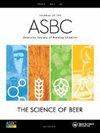Investigating the Effect of Farm Management, Soil, and Climate on Hop Diastatic Potential
IF 1.8
4区 农林科学
Q4 BIOTECHNOLOGY & APPLIED MICROBIOLOGY
Journal of the American Society of Brewing Chemists
Pub Date : 2021-10-19
DOI:10.1080/03610470.2021.1977902
引用次数: 4
Abstract
Abstract To investigate potential sources for field-to-field variation in hop diastatic power, three varieties of hops (Mosaic®, Simcoe®, and Strata®) from harvest year 2019 were collected from different fields managed by a single hop grower throughout the hop growing region within Oregon’s Willamette Valley. Fields for this study were selected based on soil type and weather patterns, and eleven fields were identified for sampling (3 Mosaic®, 3 Strata®, and 5 Simcoe®). Farm management data on fertilization rates and pesticide applications were collected by the grower (Coleman Agriculture). Using USGS soil maps, five individual sites within each field were identified for soil sampling, and hop bines near those sites were GPS tagged and hand harvested when they were at similar maturities. After harvest, the hops were analyzed for enzymatic activity using an HPLC method. The relationships between hop enzymatic activity and the farm management, soil, and weather data yielded associations with soil texture, growing degree day accumulation, fertilization practice, and pesticide application. The data also suggest a potential link between hop diastatic power and downy mildew (Pseudoperonospora humuli) or powdery mildew (Podosphaera macularis) infection. The links between hop diastatic power and agronomic variables will allow farmers to minimize hop creep potential in the hop field thereby potentially mitigating the effects that brewers see in the cellar.研究农场管理、土壤和气候对啤酒花破坏潜力的影响
摘要为了研究啤酒花非稳态功率场间变化的潜在来源,从俄勒冈州威拉米特山谷啤酒花种植区的不同田地收集了2019收获年的三个啤酒花品种(Mosaic®、Simcoe®和Strata®),由一名啤酒花种植者管理。根据土壤类型和天气模式选择本研究的田地,并确定了11个田地进行采样(3个Mosaic®、3个Strata®和5个Simcoe®)。种植者收集了有关施肥率和农药施用的农场管理数据(Coleman Agriculture)。使用美国地质调查局的土壤地图,确定了每个田地内的五个单独地点进行土壤采样,并对这些地点附近的啤酒花进行了GPS标记,并在其成熟度相似时手工收割。收获后,使用HPLC方法分析啤酒花的酶活性。啤酒花酶活性与农场管理、土壤和天气数据之间的关系与土壤质地、生长程度、日积累、施肥实践和农药施用有关。数据还表明,啤酒花的离心力与霜霉菌(Pseudoperonospora humuli)或白粉菌(Podosphaera macularis)感染之间存在潜在联系。啤酒花非平衡力和农艺变量之间的联系将使农民能够最大限度地减少啤酒花田中啤酒花的蠕变潜力,从而可能减轻酿酒商在地窖中看到的影响。
本文章由计算机程序翻译,如有差异,请以英文原文为准。
求助全文
约1分钟内获得全文
求助全文
来源期刊

Journal of the American Society of Brewing Chemists
工程技术-生物工程与应用微生物
CiteScore
4.00
自引率
20.00%
发文量
41
审稿时长
3 months
期刊介绍:
The Journal of the American Society of Brewing Chemists publishes scientific papers, review articles, and technical reports pertaining to the chemistry, microbiology, and technology of brewing and distilling, as well as the analytical techniques used in the malting, brewing, and distilling industries.
 求助内容:
求助内容: 应助结果提醒方式:
应助结果提醒方式:


